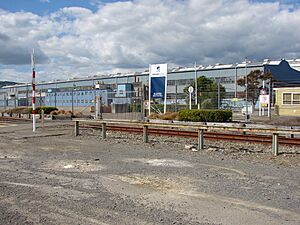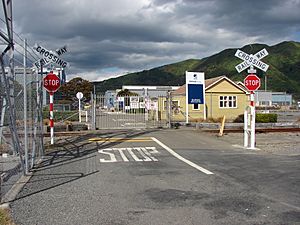Hutt Workshops facts for kids
| Division of KiwiRail | |
| Industry | Railways |
| Predecessor | Petone Workshops |
| Founded | 1930 |
| Founder | New Zealand Railways |
| Headquarters |
,
New Zealand
|
|
Area served
|
New Zealand |
| Services | Heavy rail maintenance |
|
Number of employees
|
c. 180 (2011) |
| Parent | KiwiRail |
The Hutt Railway Workshops is a big place in Lower Hutt, New Zealand. It's where trains are fixed and built. This workshop is owned by KiwiRail, which runs New Zealand's trains. It opened a long time ago, in 1930. It's the main place where KiwiRail keeps its trains and other railway vehicles in good shape.
Contents
The Story of Hutt Workshops
Before Hutt: Petone Workshops
Before the Hutt Workshops, there was another workshop in a place called Petone. It was right next to the railway station. This older workshop started in 1876. It was first used to store special "Fell" locomotives. It closed down in 1929 when the new Hutt Workshops opened.
Why a New Workshop Was Needed
In the 1920s, the old railway workshops were getting too small. They couldn't handle all the work. So, in 1924, a special group called a Royal Commission was set up. It had two railway experts from England. They looked at the problem and suggested some changes.
Their report said that some smaller workshops in the North Island could close. The bigger repair jobs could then be done at the Petone and Newmarket workshops.
Later, in 1928, the Minister of Railways said that the two main North Island workshops were "hopelessly inadequate." This meant they were not good enough. So, land was bought in Lower Hutt and Otahuhu to build new, modern workshops.
At first, the plan was for Otahuhu to fix locomotives. Hutt was supposed to work on train cars and wagons. But they found out the land at Otahuhu wasn't strong enough for heavy locomotive machines. So, they swapped the plans. Hutt became the main place for locomotives.
Building the New Workshops at Woburn
In 1925, a law called the Hutt Valley Lands Settlement Act was passed. This allowed the government to buy a lot of land, about 625 acres (253 hectares). Some of this land was for the railway, some for the new workshops, and some for roads and houses.
The new workshops were built near a railway line called the Gracefield Branch. This line also helped other factories in the area get their goods by train.
The workshops were finished in 1929 and officially opened in 1930. They had all the newest and best equipment. They could build brand new locomotives and do all kinds of repairs.
Better Air for Workers
One big improvement for the workers was the new air system. At the old Petone workshops, the air system was very basic. It just used windows and roof vents. But at Hutt, a much better system was put in. It used pipes and fans to bring in cool air from outside or warm air from steam boilers. This made the workshops a much more comfortable place to work.
First Trains Built at Hutt
The first trains built at Hutt were small "Prairie" type "C" shunting engines. Twelve of these were made. They were meant to replace older steam trains. But they ended up pulling passenger trains in Wellington. They were the last steam locomotives to work in Wellington before diesel trains arrived.
After the C-class, the K class locomotives were built. The first one, K 900, became famous when it left the workshops in 1932. The very last steam locomotives made at Hutt were Ka class 958 and 959 in 1950. But they kept being repaired there until the mid-1960s.
From the 1930s to the 1980s, Hutt Workshops also took care of Wellington's electric locomotives. The first electric trains, the ED class, started service in 1938. Then came the EW class in 1952. All these electric trains stopped regular service by the mid-1980s.
Recent Changes at the Workshops
In the late 1980s and 1990s, the workshops went through many changes. Some parts of the business were removed, and some buildings were moved. For example, the old office building for the workshops was moved to Greytown. It became a hotel and restaurant called The White Swan Hotel.
The workshops also changed owners several times.
- First, the government's Railways Department owned and ran it.
- Then, it became the Railways Corporation in 1982.
- After that, it was New Zealand Rail Limited from 1991.
- In 1993, New Zealand Rail was sold to a private company and renamed Tranz Rail in 1995.
- In 2003, Toll New Zealand bought Tranz Rail.
- Finally, in 2008, the New Zealand Government bought it back. It was renamed KiwiRail.
On April 1, 2002, a company called Alstom took over running the Hutt Workshops. They had a seven-year contract to fix Tranz Rail's trains. Three years later, in 2005, another company called United Group bought Alstom's transport business in New Zealand and Australia. This included the Hutt Workshops.
When the New Zealand Government bought back the rail business from Toll, the Hutt Workshops also became part of KiwiRail on July 1, 2008. United Group Rail continued to run the workshops until their contract ended in 2009. From March 23, 2009, KiwiRail took full control of the workshops.
KiwiRail is the main user of the workshops. But sometimes, other railway groups use the workshops too. For example, the workshops helped fix some KiwiRail EO class electric locomotives. These trains were used for a while on the Wellington suburban rail network. This was a temporary solution before new electric trains arrived in 2010.
Locomotives and Railcars Built at Hutt Workshops
Here are some of the different types of trains and railcars that were built or put together at the Hutt Workshops:
- C class (12 built)
- E class (1 built at Petone)
- L class (3 built at Petone)
- K class (30 built)
- KA class (35 built)
- DC class (5 rebuilt from DA class)
- DQ class (16 rebuilt)
- ED class (7 put together)
- Standard (Aotea) Railcars (6 built)
- Wairarapa Railcars (6 built for the Rimutaka Incline)




